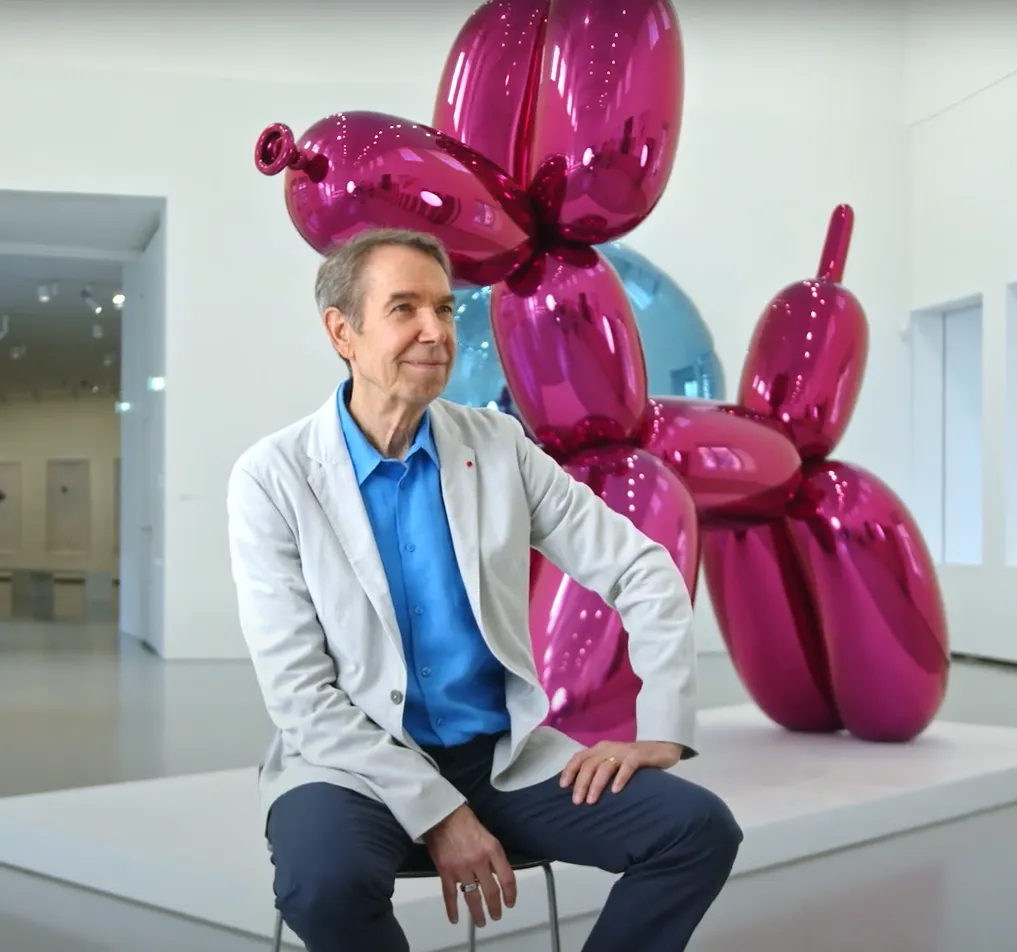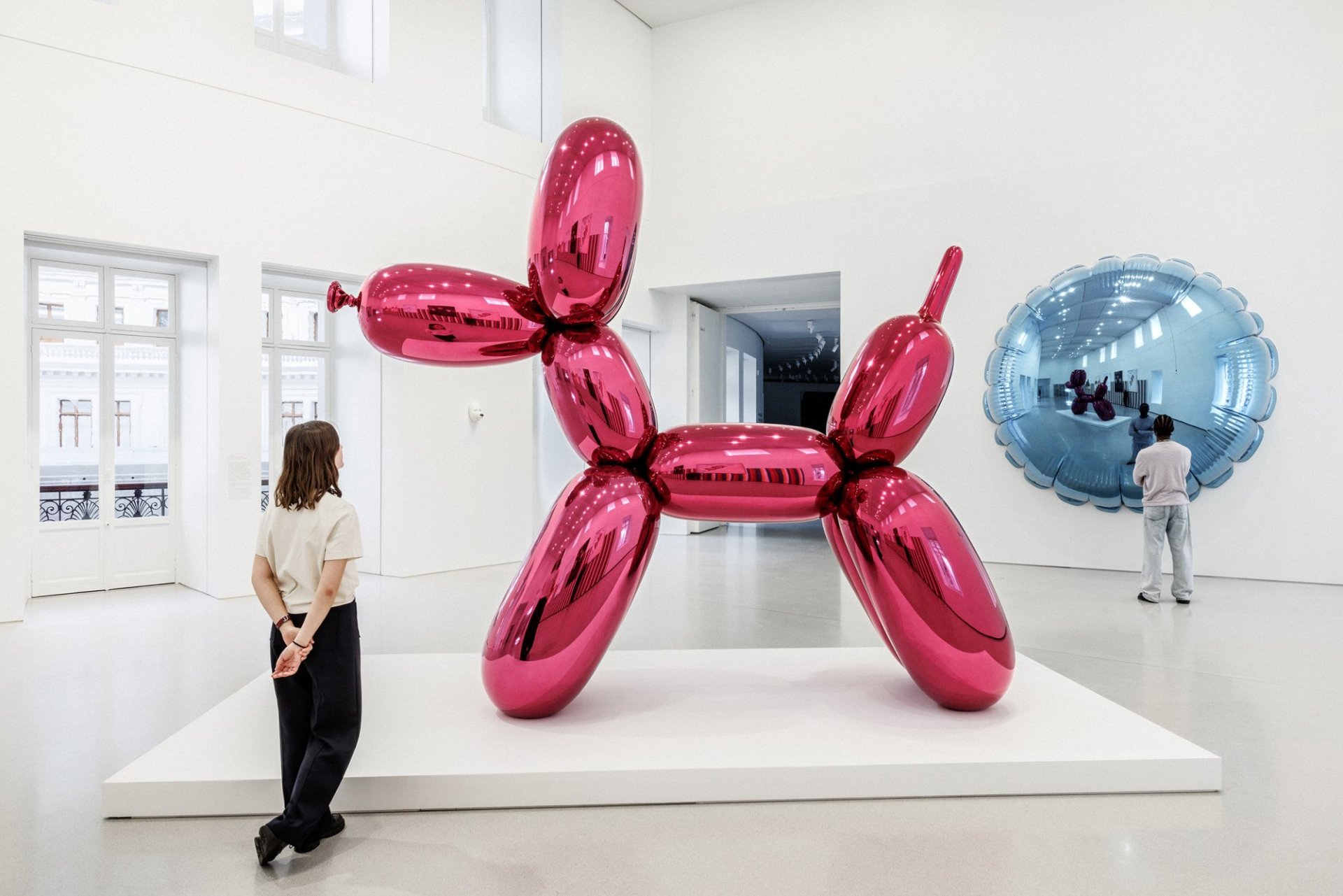
"You finish the work of art. Its meaning is found within you" — Jeff Koons
American artist Jeff Koons takes a look back at his artistic practice and talks about his works on display as part of the exhibition "Le monde comme il va".
Your art seems connected to the world of childhood. Is this linked to your personal history?
Many of the artworks that I work with, they're ready-mades, and many of them come from my own childhood, from my own experience. Growing up, my parents had a travel bar. And for my parents, it was really a symbol, I believe, of social mobility. If they would go with their friends on a vacation, they would always take their travel bar. And I grew up in in the mid-fifties, but always with the idea that the future looked better. There was a way of continuing to become. I know that not all people had that same experience or had those same feelings, but my work connects to these types of aspirations for transcendence.
Many of your works are staged everyday objects. Where does this come from?
I've been influenced by display. My father had a furniture store, and so I would grow up visiting my father's showroom, and I would see objects just displaying themselves. So I always like this aspect of looking at it and relating it to the self and that, you know, this just looking at something from an exterior perspective and at the same time thinking about an internal life.
When I moved to New York and I let my work just develop in more of an objective way, I was very attracted to display. The idea of just the presentation of an object. Because we present ourselves to the world, we present our ideas to the world, we're constantly presenting ourselves or absorbing the world as it's presented to us.
The two sculptures, Balloon Dog and Moon, are part of your iconic “Celebration” series from the 1990s. What kind of celebration are they?
When I made my “Celebration” series, I wanted to make works that looked kind of like ready-mades. There was a sense of familiarity with these pieces, but at the same time, they're not ready-mades. The Balloon Dog: there are balloon dogs in the world, you can see them at children's parties, but they're not on this scale or the Moon at large. You know, it's like a celebration balloon, maybe it would be printed on it, “Happy Birthday” or “Happy Anniversary”. These are large pieces, but I wanted to be able to communicate kind of a mythic quality to them. The Balloon Dog, it does have that kind of festive look. But at the same time, I always thought that, in ancient times or in archaic times, a community would rally around an object like this. And maybe somebody from the community looked at their kill and they noticed that the gasses in the stomach or in the intestine started to swell and thought, “Oh, I can make something with this”. And they would take the intestine and they would form something like a balloon dog. And then the whole community would have this object in which some type of ritual would take place. So there's, again, this connection to the internal, that it comes from a profound place within us, and yet it's so externalized that we look at it and it reflects the environment around us.
And the Moon functions in the same way, connected to our celestial heavens and beyond, even the moon and the galaxy that we're in, and just relates to really kind of external celestial space.
The Balloon Dog, to me, also always had a kind of a Trojan Horse quality. You can look at it, it's bright, it's shiny, it has this large scale about it, but it's internal life. It's internal being. You really can't see. I think that it also has a darker side. It's not just, you know, all bright optimism, but to be able to have brightness, you also have to be able to have darkness. Otherwise, there's no way to even define what is bright. And it's the same with the Balloon Dog. There's this darker, interior side, too.

The idea of reflection is central to your work. Where does this fascination come from?
I started working with reflective surfaces back in the kind of mid-seventies, and I was attracted to a reflective surface because it would reflect the environment. It would reflect you, the viewer, and so, it would be communicating that this experience is about you. And so, if you look at a Balloon Dog, you look at the Moon, or you look at the surfaces of a lot of my works that kind of have a shine to them, it's bringing you into connection that everything's about you. You finish the work of art. Its meaning is found within you. And I believe that that's always what just intuitively always connected me to the idea of reflection and to have it be within the work, so that anybody looking at it could realize that this is about you, what we believe we can become. That's what art is. And these are just objects. Works of art are just objects that can give us insight into the essence of our potential.
Your earliest work in the Pinault Collection features two vacuum cleaners in a display case.
When I made the series “The New”, I wanted to make works that would be participating within the Duchamp tradition, but hopefully be able to add something to that. And so, I was thinking about objects having their greatest integrity when they're born, when they're brand new, and that this integrity is able to be maintained and displayed by not being used, where, as individuals, for us to develop integrity, we have to participate. We're not kind of just born with it, but it comes through participation. And I thought that there's this confrontation between the two of who is really better prepared to survive and has a better chance to be eternal, whether it's the biological viewer or the inanimate object. But the designs do change, and the materials also, over time, start to yellow, some of the plastic… different changes happen, but it's like us as individuals, too. We also change, and the world changes around us. So at the same time, it's embracing the idea and a dialog of what it really means to go on. The concept of the eternal, almost the ideal. Well, maybe there is no change, but then it brings you to embrace change. That change could be the ideal.
How do you explain the fact that some of your works have become icons and part of popular culture?
You know, if an artist is able to make works that are, in a profound way, able to touch people's lives in more of a mass way, I think it can only come from trusting in yourself. And if you trust in yourself and you just follow your interests, it connects you to a universal vocabulary. The way we are able to interact with objects and ideas today, we may interact with differently in the future. It's very hard to be able to know. But I do believe that if we focus on things, and the more you focus on your interests, the more you can connect to what's relevant to us as human beings.
If I look at my work, I realize that there's a sense of optimism. I think that the optimism aspect of my work is the main pull. And we do have an opportunity to become, to expand our being, to have a greater sense of ourselves, to become more, and we can share that with others. And so that's why I lean towards optimism.
Can you tell us about your meeting with François Pinault?
My relationship with François Pinault started back at the end of the nineties. I met François, and of course, I was impressed that, somebody so engaged with art, really a love of art, personally connected to art.
As a young artist, there's a moment where collectors really aren't that close within your life, but then you start to trust and be engaged with collectors. And François was very disarming. He's a person that loves art, is engaged as a collector, and he understands it. He understands that art permeates our lives, becomes part of our lives, and that we share and communicate really important information through the arts. I think many of the people that you know in the art world today, as international artists, really have a lot of thank François for, in being able to share the work internationally. I can feel the personality of François in the collection, and it's a personality that has intellect and insight, but it's also a personality that has humour, joy. It understands sadness, but there's hope everywhere.
Your works are part of the exhibition "Le monde comme il va": what does this title evoke for you?
I'm really happy to be at the Bourse de Commerce today. And it's amazing what François has created. And he's wanted to have a home for that collection. It's wonderful that here in the city of Paris, where the Bourse de Commerce is located. And he's able to have these different exhibitions, like the one today. If I think of titles for exhibitions, something that rallies, brings, works together, Le monde comme il va, I mean, what a title. What a beautiful thought. Because we do have the freedoms. We wake up with the freedoms every day to create what we want. We can take extreme action in this direction, or extreme action in another. And there are consequences for these actions, too. We have responsibilities to ourselves; we have responsibilities to others. And all of this comes into dialogue as a whole history of human activity. And all of it's involved in this exhibition. So it's so meaningful to me to be part of it.
__
L'exposition « Le monde comme il va » est présentée jusqu'au 2 septembre 2024 à la Bourse de Commerce